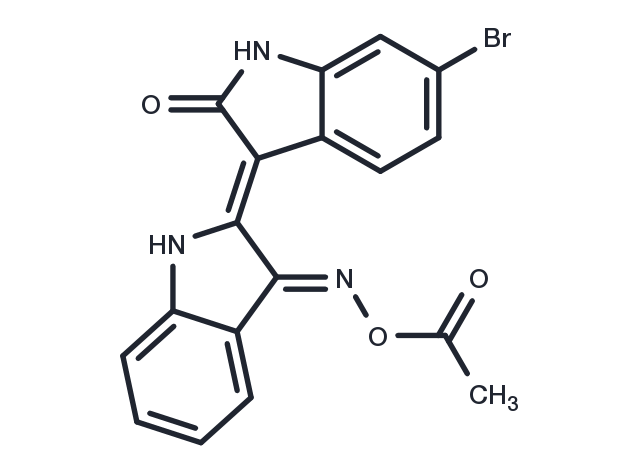Powder: -20°C for 3 years | In solvent: -80°C for 1 year


BIO-acetoxime (GSK-3 Inhibitor X) is a potent dual GSK3α/β inhibitor with IC50 of 10 nM, <240-fold selectivity over CDK5/p25, CDK2/cyclin A and CDK1/cyclin B.

| Pack Size | Availability | Price/USD | Quantity |
|---|---|---|---|
| 1 mg | In stock | $ 34.00 | |
| 2 mg | In stock | $ 48.00 | |
| 5 mg | In stock | $ 72.00 | |
| 10 mg | In stock | $ 115.00 | |
| 25 mg | In stock | $ 263.00 | |
| 50 mg | In stock | $ 396.00 | |
| 100 mg | In stock | $ 589.00 | |
| 1 mL * 10 mM (in DMSO) | In stock | $ 72.00 |


| Description | BIO-acetoxime (GSK-3 Inhibitor X) is a potent dual GSK3α/β inhibitor with IC50 of 10 nM, >240-fold selectivity over CDK5/p25, CDK2/cyclin A and CDK1/cyclin B. |
| Targets&IC50 | GSK-3α:10 nM, GSK-3β:10 nM |
| In vitro | In human oral epithelial cells, BIO-acetoxime suppresses viral gene expression and protects oral epithelial cells from HSV-1 infection. [2] In SY5Y-MYCN cells, BIO-acetoxime strongly reduces c-MYC expression and p-SMAD3 levels. BIO-acetoxime also decreases cell viability of KCN, KCNR, SY5Y, Kelly, and IMR32 cells by mediating apoptosis. [3] In HEK 293T cells, BIO-acetoxime is also found to reduce antiviral innate immunity downstream of IRF3 activation by inhibition of GSK3α/β activities. [4] |
| Kinase Assay | Kinase Assays: Kinases activities are assayed in Buffer A or C, at 30 °C, at a final ATP concentration of 15 μM. Blank values are subtracted and activities calculated as pmoles of phosphate incorporated for a 10 min incubation. The activities are expressed in % of the maximal activity, i.e., in the absence of inhibitors. Controls are performed with appropriate dilutions of DMSO. GSK-3α/β is purified from porcine brain by affinity chromatography on immobilized axin. It is assayed, following a 1/100 dilution in 1 mg BSA/mL 10 mM DTT, with 5 μL 40 μM GS-1 peptide as a substrate, in buffer A, in the presence of 15 μM [γ-33P] ATP (3000 Ci/mmol; 1 mCi/mL) in a final volume of 30 μL. After 30 min incubation at 30 °C, 25 μL aliquots of supernatant are spotted onto 2.5 × 3 cm pieces of Whatman P81 phosphocellulose paper, and, 20 s later, the filters are washed five times (for at least 5 min each time) in a solution of 10 mL phosphoric acid/liter of water. The wet filters are counted in the presence of 1 mL of ACS scintillation fluid. CDK1/cyclin B is extracted in homogenization buffer from M phase starfish (Marthasterias glacialis) oocytes and purified by affinity chromatography on p9CKShs1-sepharose beads, from which it is eluted by free p9CKShs1. The kinase activity is assayed in buffer C, with 1 mg histone H1 /mL, in the presence of 15 μM [γ-32P] ATP (3000 Ci/mmol; 1 mCi/mL) in a final volume of 30 μL. After 10 min incubation at 30 °C, 25 μL aliquots of supernatant are spotted onto P81 phosphocellulose papers and treated as described above. CDK5/p25 is reconstituted by mixing equal amounts of recombinant mammalian CDK5 and p25 expressed in E. coli as GST (Glutathione-S-transferase) fusion proteins and purified by affinity chromatography on glutathione-agarose (p25 is a truncated version of p35, the 35 kDa CDK5 activator). Its activity is assayed in buffer C as described for CDK1/cyclin B.0 |
| Cell Research | Cell viability is analyzed by CellTiter 96 AQueous One Solution Cell Proliferation Assay according to manufacturer's instructions, approximately 5,000 cells are plated per well of 96-well tissue culture plates with 100 μL of medium. To assess cell viability, rather than proliferation rate, inhibitor- and control-treated cells are assayed after the same growth time had elapsed. The results represent the mean ± SD of triplicate samples, expressed as a percentage of control.(Only for Reference) |
| Synonyms | BIA, GSK-3 Inhibitor X |
| Molecular Weight | 398.21 |
| Formula | C18H12BrN3O3 |
| CAS No. | 667463-85-6 |
Powder: -20°C for 3 years | In solvent: -80°C for 1 year
DMSO: 8 mg/mL (20 mM)
You can also refer to dose conversion for different animals. More
bottom
Please see Inhibitor Handling Instructions for more frequently ask questions. Topics include: how to prepare stock solutions, how to store products, and cautions on cell-based assays & animal experiments, etc.
BIO-acetoxime 667463-85-6 Apoptosis Microbiology/Virology PI3K/Akt/mTOR signaling Stem Cells GSK-3 HSV BIO acetoxime Glycogen synthase kinase 3 BIA inhibit Herpes simplex virus Glycogen synthase kinase-3 GSK-3 Inhibitor X Inhibitor BIOacetoxime inhibitor
